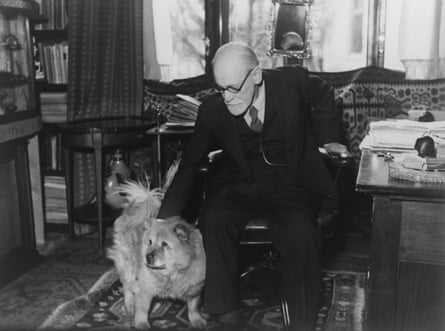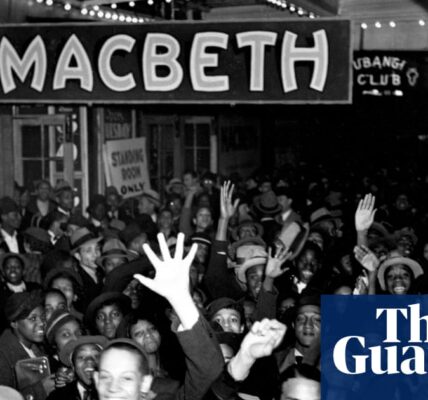A
In light of the constant sound leak from the BBC and Hitler’s vow to wipe out the Jewish population in Europe, a new movie called “Freud’s Last Session” aims to take advantage of a year that saw a resurgence of interest in Sigmund Freud and psychoanalysis.
The movie begins with two duos – first, Freud and Freud: Anna (played by Liv Lisa Fries) playfully teases her father Sigmund (played by Anthony Hopkins) who is on his couch taking a nap. Anna makes a joke about her father being alive, but we already know from the title of the film that this won’t be true for long. In another part of England, Janie Moore (played by Orla Brady), a maternal figure, pleads with CS Lewis (played by Matthew Goode) to cancel his plans and stay safe inside. Despite their challenges – Freud’s painful jaw cancer and the threat of bombings on Lewis’s train – both men persist and come together to discuss the truth of God’s existence.
Lewis is running behind schedule. Fictional Freud, always a stickler for adhering to the rules of meetings (such as time and fees, which psychoanalysts refer to as “the frame”), is not impressed. His dog, Yofi, who is a renowned chow and the first therapy animal in psychoanalytic history (although the film does not acknowledge it), shares the sentiment.
When we enter Freud’s office, we witness what appears to be a heated argument between two important figures discussing the existence of God. However, the issue is that this meeting never actually took place.
It is delightful to imagine a famous fantasy writer and a renowned fantasy theorist debating the significance of fantasy. However, the 100-minute discussion that takes place is not quite what we expect. If Freud and Lewis were participating, they would be disappointed with the lack of depth in the argument. While Lewis firmly believes in the existence of God, Freud’s beliefs are not as clear cut (although there is a body of research that suggests his relationship with faith was more complex). Throughout their meeting, both individuals simply reiterate their initial stances. In the middle of their conversation, Freud interrupts to turn on the radio to listen to the latest news from BBC. He learns that England has declared war on Germany and simply remarks, “So it begins.”
“Again,” rejoins Lewis.

Currently, there is a lot of focus on Freud and his theory of mind. This is happening at a time when mental health and trauma have become widely discussed topics in both public health and culture. As a result, there is a desire to move beyond simple solutions like medication and cognitive behavioral therapy, and instead explore the broader theory of mind proposed by Freud and his followers. In addition, there is a growing realization that the losses experienced by the left go beyond just material losses, but also have psychological and social implications.
There has been a lot of discussion, including my own, about the reason behind the resurgence of interest in Freud. There are rumors that psychoanalysis has made a comeback, as seen in publications like the New Yorker, New York Magazine, the Financial Times, and the New York Times. In our own institution, the Psychosocial Foundation, which I co-direct with clinician Alex Colston, over a thousand students each year study the social aspect through psychoanalysis, following in the tradition started by Freud. Our psychoanalysis magazine, Parapraxis, has grown at a much faster rate than we anticipated or were prepared for.
As a psychologist who specializes in history, I have noticed that the field has become increasingly important. Graduate students often seek advice during office hours on how to integrate the principles of Freud and his followers into their research, either as a methodology or from a historical perspective. My colleagues at other universities have shared their success in teaching full lectures on the history of psychoanalysis, with waitlists and enthusiastic interest from students.
However, the time period depicted in Freud’s Last Session and its upcoming release in December has seen fluctuations in Freud’s success, recurring in a cyclical pattern.

Recently, he has been making a comeback after being discredited for several decades. He was only briefly mentioned (and often labeled as a fraud) in basic psychology courses, and in society he was portrayed as sexually deviant and potentially anti-Semitic. His theories were dismissed due to their perceived lack of proof.
The use of psychoanalysis as a metaphor is still a commonly used way to discuss romantic and parent-child relationships. It refers to our understanding of different types of relationships, both close and distant, such as “transference” and “parasocial” relationships with strangers. Despite criticism, psychoanalysis continues to hold influence. As Harold Bloom stated, attempting to reject Freud’s ideas will not make them disappear, as they have become ingrained in our thinking and are difficult to escape.
T
This is not the initial Christmas that has caused murmurs of a revival of Freud’s ideas. The late writer David Rakoff even portrayed Freud in the holiday display of Barneys department store on Madison Avenue in New York and “treated” shoppers on his couch as far back as 1996. As a child, Freud himself was exposed to Christmas annually in Catholic Bavaria and even attended church. Films about Freud have been circulating for almost a century. Despite Freud’s interest in home movies (and his frequent appearances in them), he did not trust the professional medium. Hollywood attempted to involve Freud in film consulting in the 1920s, but he declined (and urged his followers to do the same). In the 1940s and beyond, psychoanalytic Hollywood contributed to the first wave of Freud mania in the US and internationally, with psychoanalysts observing film sets and actors like Marlon Brando and Cary Grant publicly crediting psychoanalysis as integral to their life and work. With all this commotion, the first biographical film about Freud, appropriately titled Freud, came out somewhat late in 1962. Starring Montgomery Clift, the film was originally written by Jean-Paul Sartre and would have had a runtime of 12 hours (but was eventually cut down, with Sartre removing himself from the project). Moving ahead to our current century, we have seen both documentaries and biopics about Freud – from The Century of the Self (2002) to A Dangerous Method (2011). It is more accurate to say that Freud is rarely out of the spotlight than to say that he has made a comeback to it.
However, this resurgence of Freud’s ideas has a distinct feeling to it. This is because an increasing number of individuals are not simply curious about Freud’s teachings, but are also eager to experience his treatment methods for themselves. As author Rachel Connolly shares about her own successful journey in therapy: “Since beginning my analysis, I’ve observed that more and more of my friends and acquaintances are also giving it a try, similar to when you learn a new word and suddenly notice it everywhere.”

It is clear that those who are not involved in analysis are fixated on what happens in the analyst’s office. The recent rise of quality television has given us numerous fictional portrayals of analytic therapy, such as The Sopranos and In Treatment. Additionally, Esther Perel’s show Where Should We Begin? and Orna Guralnik’s reality show Couples Therapy have allowed us to listen in on actual therapy sessions, both gaining a devoted following. Psychoanalysis continues to be the dominant framework for understanding human relationships in the 21st century, despite its origins in the 20th century as a theory of sexuality, desire, love, and aggression. We may not realize it, but we still consume psychoanalysis in various diluted forms. Even though the “Freud Mania 1.0” of the 1950s and 1960s has long passed, we continue to engage with psychoanalysis on a regular basis.
F
For those newly interested in Freud, now may seem like the perfect time to see him resurrected for Christmas. However, Freud’s Last Session is not a good introduction to psychoanalysis, despite Anthony Hopkins’ enjoyable portrayal of Freud. The film relies on myths and metaphors instead of Freud’s scientific theories, using historical events like the onset of World War II to support its fictional narrative. While it was exciting to see a replica of one of my favorite places – the London home of the Freuds – I couldn’t help but feel confused. What do we really gain from this mixture of falsehoods and alternate realities? Are we so eager for more Freud that we are willing to accept a distorted version of him, without even realizing it? Instead of exploring Freud’s complex life and legacy, the filmmakers chose to adapt a play that imagines a meeting between two contemporaries who never actually met (although the film claims that a meeting between Lewis and Freud could have happened, as Freud met someone from Oxford three weeks before he passed away). However, Freud did have numerous encounters with other famous individuals – not to mention his interactions with influential women – all of which could have made for more captivating films.

The portrayal of history in this film is highly sensationalized. The relationship between Sigmund and Anna is depicted in a harsh and unsympathetic manner, without any context. For example, there is a scene where Anna is shown almost pleasuring herself on her father’s couch during a therapy session. While their relationship was undoubtedly complex and she was his patient, there is no evidence to suggest that this actually occurred. The film also uses outdated language to describe their relationship as co-dependent and unhealthy. In contrast, the film portrays Anna as openly gay and in love with the last Tiffany heiress. While Freud appears to accept her sexuality, as long as it is not directed towards him, in reality, he held more accepting views on homosexuality than his son. Instead of being recognized as the father of the theory of the psyche, Freud is depicted as a mad, controlling, and quietly homophobic genius who desires his daughter in an inappropriate way.
Freud’s jaw cancer is often seen as a reflection of his personality. Despite the fact that Freud, both in the movie and in real life, is nearing the end of his life due to excruciating pain, the focus is on why he would want his daughter to be with him or on quiet remarks speculating about his closer relationship with his daughter compared to his wife (who is never shown).
The movie fails to take advantage of chances to move beyond sensationalized rumors and instead allow the two historical figures to engage in a battle of ideas. Freud’s contributions are consistently downplayed and assumed to be fully integrated into society (the Oedipus complex is simplified into a brief statement or joke). The director, Matt Brown, and the source material portray Freud as a “sex doctor”, possibly influenced by how he was portrayed in the media rather than celebrated for his work.
The film subtly prompts us to consider the boundaries and essential role of psychoanalysis in the face of complete destruction. As the war rages on in Palestine, even my most skeptical friends have become curious about how incorporating psychological thinking can enhance our understanding of politics, whether through Freud himself or his successors such as Frantz Fanon. How can we grasp concepts like revenge, fear of annihilation, the urge to destroy, the need for unwavering security and its absence, perseverance, and the desire to continue existing without considering the psyche? However, while Freud’s Last Session touches upon war, it mainly serves as a backdrop for the two main characters. When CS Lewis experiences a bout of anxiety during the sound of sirens, reminiscent of his time fighting in a previous war – a moment that could have been poignant – Sigmund Freud, renowned for his work on war neurosis, simply advises him to take deep breaths. He was not exactly the mindfulness coach that he is often portrayed as.

The film does not allow psychoanalysis to make a meaningful impact on society. However, in this alternate scenario, Freud’s final session was not actually an analytical one. Despite his revival as a theorist for understanding the suffering in the world and for providing therapy, Freud’s followers must still confront a distorted portrayal of him in biopics that is detached from the reality of his own life. As long as Freud remains relevant, so will the debates surrounding his ideas.
The concept of psychoanalysis is often dismissed as a joke or a scam, but with the resurgence of interest in Freud, it has been treated disrespectfully. Each generation seems to have their own version of the Freud story. This film teaches us that despite what we may think we know about Freud, it is important to view him as a theorist and to thoroughly read and study his work, as well as the work of those who followed him (including his daughter). The impact of psychoanalysis, from the war evacuations organized by Freud’s followers to its effectiveness in treating trauma, is both significant and still relevant today.
Source: theguardian.com
